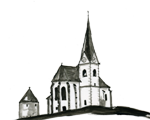English
Maria Wörth

History and architecture of the church Maria Woerth
First document mentioning a church founded by Freising in 849. Original parish and missionary center, consecration of the church to St. Primus and Felicianus. Founding of a collegial monastery, first provost 1151. After a devastating fire in 1399 slow reconstruction. The present day late gothic church was built on the remains of the roman building – namely parts of the crypt, and the southern arched gateway. The nave is raised above the crypt with tracery windows. The southern side nave is separated by round pillars and is complemented by an extension with the sacristy. The northern steeple carries five bells. One from 1640, three from 1959 and the new “Bell of Peace” from 1994. The roman ossuary to the east of the church now serves as a chapel of rest. In 1529 the provostship was given to the Knights Order of St. George. In 1589 the chapter came to an end after more than 450 years existence and the estates were given to the Jesuits. Following the abolition of the Jesuit order in 1773 the spiritual welfare of Maria Wörth was taken care of by world priests. In 1808 the parish was subordinated to the Benedictine monastery of St. Paul im Lavanttal (in eastern Carinthia). This patronage ended in 1969.
Interior
Baroque main altar from 1658 honouring the Holy Trinity, with Madonna and child on throne from 1460, flanked by the patrons of the church St. Primus and St. Felicianus, above them St. Catherine, St. Barbara and crowned off by St. Ignatius and St. Franz Xaver.
Baroque side altar from (ab.1740) with “Mater Dolorosa” and late gothic naturalistic crucifix (early 16th. Century).
Baroque pulpit from 1761 with images of the four evangelists and scenes from the life of Christ on the sides. On top confirmation of the order of the Jesuits by Pope Paul III.
Marble baptismal basin with wooden cornice from 1682. On this allegoric images of the perishability ofman.
In the tower chapel an altar with a more modern carved figure of the Holy Heart of Jesus in center and rococo style portrayals of Holy Primus and Felicianus on either side.
The Parish of Maria Woerth today
The ceremonial masses of Christmas and Easter find their secular supplement in vocal concerts and organ music on summer evenings as well as instrumental and vocal performances full of atmosphere in the weeks before Christmas. The parish fair on the 15th of August – Marias Ascension – is a highlight. On that day the procession of boats round the lake finds its crowning finish here in Maria Wörth. The celebration of Corpus Christi procession in June, the blessing of local herbs, presented by the local folks group in their traditional costumes in August and the pilgrimage of churches in September, when all five churches of the parish are visited for worship on foot, are also events well worth taking part in.
Thank you for your visit to Maria Wörth. May God bless you and your Beloved.

